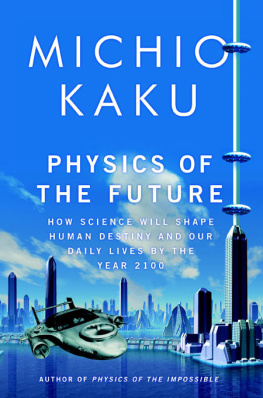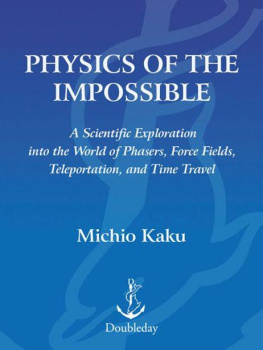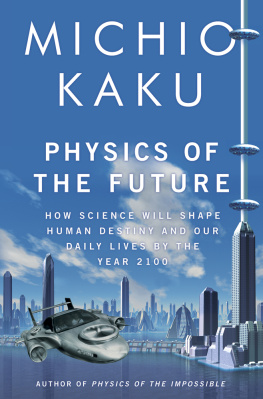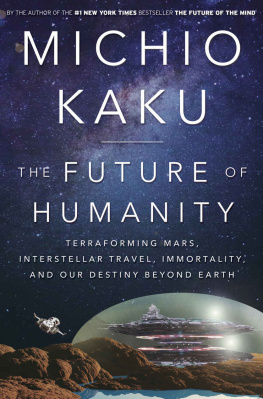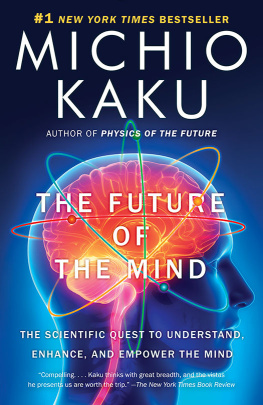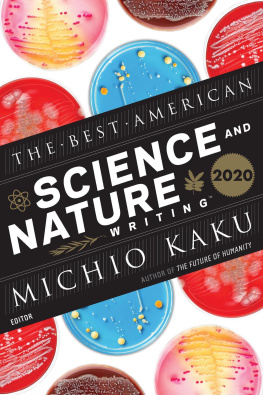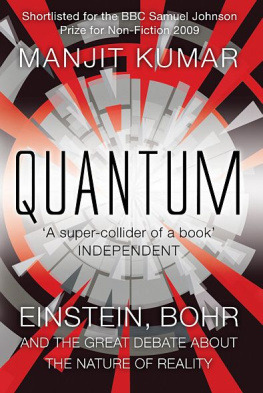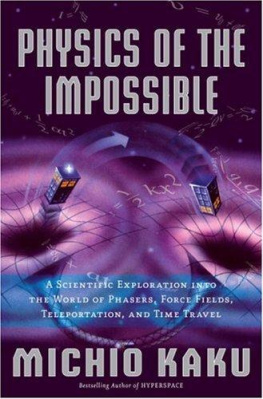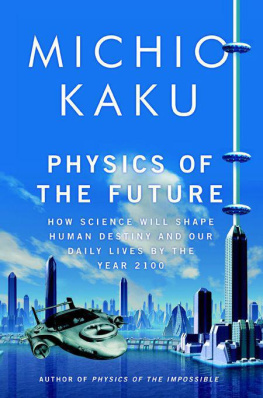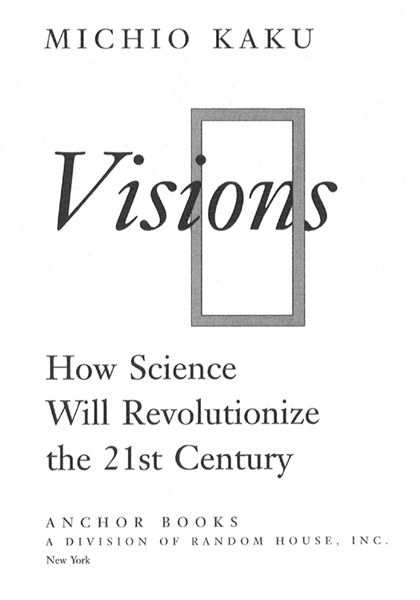Michio Kaku
Visions
Michio Kaku is the Henry Semat Professor of Theoretical Physics at the City College of New York. Cofounder of string field theory, he is the author of the critically acclaimed and bestselling Hyperspace, as well as Beyond Einstein (with Jennifer Thompson), Quantum Field Theory: A Modern Introduction, and Introduction to Superstrings. He hosts an hour-long weekly radio science program that is nationally syndicated.
Other Books by Michio Kaku
HYPERSPACE
BEYOND EINSTEIN
F IRST A NCHOR B OOKS E DITION , O CTOBER 1998
Copyright 1997 by Michio Kaku
All rights reserved under International and Pan-American Copyright Conventions. Published in the United States by Anchor Books, a division of Random House, Inc., New York, and simultaneously in Canada by Random House of Canada Limited, Toronto. Originally published in hardcover in the United States by Anchor Books in 1997.
Anchor Books and colophon are registered trademarks of Random House, Inc.
The Library of Congress has cataloged the Anchor hardcover edition of this book as follows:
Kaku, Michio.
Visions: how science will revolutionize the 21st century
Michio Kaku.
p. cm.
1. ScienceMethodology. 2. ScienceForecasting. 3. TechnologicalForecasting.
4. Quantum theory. 5. Molecular biology. 6. Computers and civilization. 7. Twenty-first centuryForecasting. I. Title.
Q175.K157 1997
501.12dc21 97-18493
eISBN: 978-0-307-79477-2
www.anchorbooks.com
v3.1_r1
This book is dedicated to my parents
Contents
CHAPTER 1
Choreographers of Matter, Life, and Intelligence
CHAPTER 2
The Invisible Computer
CHAPTER 3
The Intelligent Planet
CHAPTER 4
Machines That Think
CHAPTER 5
Beyond Silicon: Cyborgs and the Ultimate Computer
CHAPTER 6
Second Thoughts: Will Humans Become Obsolete?
CHAPTER 7
Personal DNA Codes
CHAPTER 8
Conquering CancerFixing Our Genes
CHAPTER 9
Molecular Medicine and the Mind/Body Link
CHAPTER 10
To Live Forever?
CHAPTER 11
Playing God: Designer Children and Clones
CHAPTER 12
Second Thoughts: The Genetics of a Brave New World?
CHAPTER 13
The Quantum Future
CHAPTER 14
To Reach for the Stars
CHAPTER 15
Toward a Planetary Civilization
CHAPTER 16
Masters of Space and Time
Preface
THIS IS A BOOK about the limitless future of science and technology, focusing on the next 100 years and beyond.
A book with the proper scope, depth, and accuracy necessary to summarize the exciting and fast-paced progress of science could not be written without the insights and wisdom of the scientists who are making the future possible.
Of course, no one person can invent the future. There is simply too much accumulated knowledge, there are too many possibilities and too many specializations. In fact, most predictions of the future have floundered because they have reflected the eccentric, often narrow viewpoints of a single individual.
The same is not true of Visions. In the course of writing numerous books, articles, and science commentaries, I have had the rare privilege of interviewing over 150 scientists from various disciplines during a ten-year period.
On the basis of these interviews, I have tried to be careful to delineate the time frame over which certain predictions will or will not be realized. Scientists expect some predictions to come about by the year 2020; others will not materialize until much laterfrom 2050 to the year 2100. As a result, not all predictions are created equalsome are more forward-looking and necessarily more speculative than others. The time frames Ive identified in the book, of course, are to be taken only as guidelines, to give readers a sense of when certain trends and technologies can be expected to emerge.
The outline for the book is as follows: In focuses on the quantum revolution, perhaps the most profound of the three, which will give us control over matter itself.
I wish to thank the following scientists who have given me their time, advice, and invaluable insights in the course of writing this book:
Walter Gilbert, Nobel Laureate in Chemistry, Harvard University
Murray Gell-Mann, Nobel Laureate in Physics, Santa Fe Institute
Henry Kendall, Nobel Laureate in Physics, MIT
Leon Lederman, Nobel Laureate in Physics, Illinois Institute of Technology
Steven Weinberg, Nobel Laureate in Physics, University of Texas
Joseph Rotbalt, physicist, Nobel Laureate in Peace
Carl Sagan, Director, Laboratory for Planetary Studies, Cornell University
Steven Jay Gould, Professor of Biology, Harvard University
Douglas Hofstadter, Pulitzer Prize winning author, Indiana University
Michael Dertouzos, Director of MIT Laboratory for Computer Sciences
Paul Davies, author and cosmologist, University of Adelaide
Hans Moravec, Robotics Institute, Carnegie-Mellon University
Daniel Crevier, AI expert, CEO of Coreco, Inc.
Jeremy Rifkin, founder of Foundation for Economic Trends
Philip Morrison, Professor of Physics, MIT
Miguel Virasoro, Director, International Center for Theoretical Physics, Trieste, Italy
Mark Weiser, Xerox PARC
Larry Tesler, chief scientist, Apple Computer
Paul Ehrlich, environmentalist, Stanford University
Paul Saffo, Director, Institute for the Future
Francis Collins, Director, National Center for Human Genome Research (NCHG), National Institutes of Health
Michael Blaese, Clinical Gene Therapy Branch (NCHG), National Institutes of Health
Lawrence Brody, Laboratory of Gene Transfer (NCHG), National Institutes of Health
Eric Green, Diagnostic Development Branch (NCHG), National Institutes of Health
Jeffrey Trent, Director, Division of Intramural Research (NCHG), National Institutes of Health
Paul Meitzer, Laboratory of Cancer Genetics (NCHG), National Institutes of Health
Leslie Biesecker, Laboratory of Genetic Disease Research (NCHG), National Institutes of Health
Anthony Wynshaw-Boris, Laboratory of Genetic Disease Research (NCHG), National Institutes of Health
Steven Rosenberg, Head of Surgery, National Institutes of Health
Lieutenant Colonel Robert Bowman, Director, Institute for Space and Security Studies
Paul Hoffman, Editor in Chief, Discover magazine
Leonard Hayflick, Professor of Anatomy at the University of California at San Francisco School of Medicine
Edward Witten, physicist, Institute for Advanced Study, Princeton
Cumrun Vafa, physicist, Harvard University
Paul Townsend, physicist, Cambridge University
Alan Guth, cosmologist, MIT
Barry Commoner, environmentalist, Queens College, CUNY
Rodney Brooks, Associate Director, Artificial Intelligence Laboratory, MIT
Robert Irie, Artificial Intelligence Laboratory, MIT
James McLurkin, Artificial Intelligence Laboratory, MIT
Jay Jaroslav, Artificial Intelligence Laboratory, MIT
Peter Dilworth, Artificial Intelligence Laboratory, MIT
Mike Wessler, Artificial Intelligence Laboratory, MIT
Neal Gershenfeld, Principal Investigator, Physics and Media Group, MIT Media Laboratory
Pattie Maes, Principal Investigator, Autonomous Agents Group, MIT Media Laboratory


